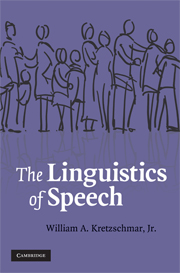Book contents
- Frontmatter
- Contents
- List of figures
- List of tables
- Acknowledgments
- The road not taken
- Introduction
- 1 The contemporary marketplace of ideas about language
- 2 Saussure
- 3 Evidence from linguistic survey research: basic description
- 4 Statistical evidence from linguistic survey research
- 5 Evidence from corpus linguistics
- 6 Speech as a complex system
- 7 Speech perception
- 8 Speech models and applications
- References
- Index
Introduction
Published online by Cambridge University Press: 03 July 2009
- Frontmatter
- Contents
- List of figures
- List of tables
- Acknowledgments
- The road not taken
- Introduction
- 1 The contemporary marketplace of ideas about language
- 2 Saussure
- 3 Evidence from linguistic survey research: basic description
- 4 Statistical evidence from linguistic survey research
- 5 Evidence from corpus linguistics
- 6 Speech as a complex system
- 7 Speech perception
- 8 Speech models and applications
- References
- Index
Summary
Modern theories of linguistics rely upon the central assumption that “Language is a system.” How could it be otherwise? How could we communicate with each other if there weren't rules for how we should talk and write, some sort of contract or agreement that we all share? Academic linguists are not the only ones to hold this view: in the schools, teachers of language arts prescribe for their students the rules of English (or other languages) so that they can get ahead in the world. The rules that linguists talk about are not always the same rules that language arts teachers talk about, but they both share the central assumption that there are indeed rules that help us to communicate with each other. Most people outside of universities and schools also hold the same assumption about rules. They believe that people around here, their neighbors, talk a certain way, and that other people from there, or at least not from here, talk a different way. American Southerners say y'all. Canadians say oot for out. British speakers say “the government are” when the Americans and Canadians say “the government is.” That is how it is with language: the rules are a little different for people in different places or different social situations. The rules are certainly different for speakers of different languages, like Spanish and English, a lot different, so different in fact that we cannot understand each other.
- Type
- Chapter
- Information
- The Linguistics of Speech , pp. 1 - 5Publisher: Cambridge University PressPrint publication year: 2009

